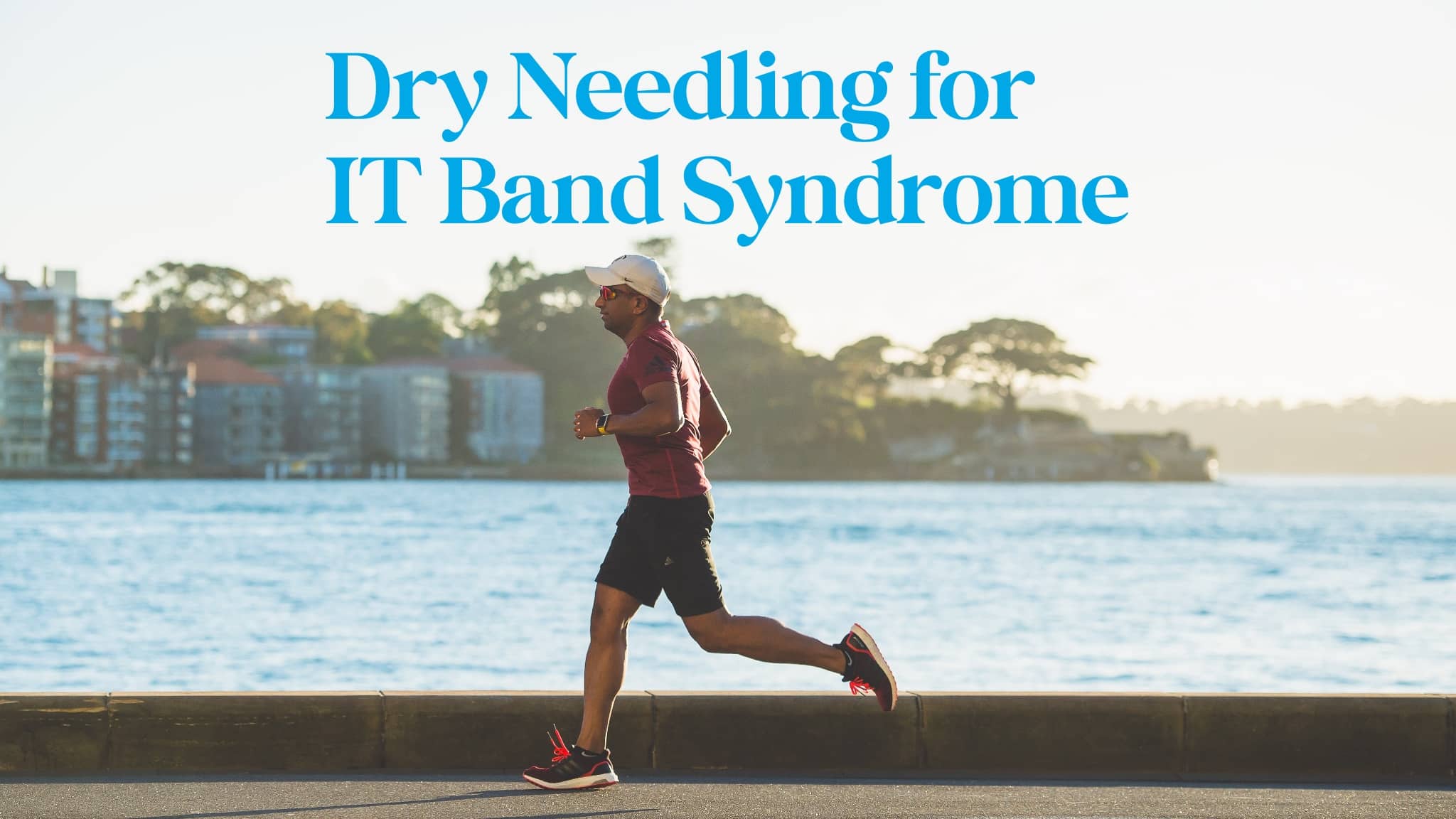Dry needling for IT band pain can help relieve muscle tightness, muscle pain, and trigger points. Chiropractors who dry needle have turned to this treatment method because it often provides quick relief for IT band syndrome. In this post I’ll discuss the treatment of IT band pain with dry needling.
In case you’re not familiar with IT band syndrome, here’s a short synopsis:
IT band pain is common in athletes, especially runners and cyclists, but really anyone who does repetitive knee flexion. It manifests in pain in the outside of the knee and sometimes underneath the kneecap. Tightness and tenderness in the side of the thigh and hip often come along with these symptoms as well.

Does Dry Needling Help IT Band Syndrome?
In my clinical experience dry needling will help relieve IT band syndrome pain. I’ve treated close to 100 cases of IT band syndrome and used dry needling as a treatment in most of them. Not only can dry needling relieve IT band pain, but it can also improve mobility and function.
The key to the use of dry needling in IT band syndrome pain is to first identify the functional problem. I do this by looking at the back, hip, and knee range of motion. 100% of the time I find a movement deficit. Next, I’ll use a functional test or system like a squat or the SFMA and get down to the root cause. The root cause is going to be a mobility problem or a motor control problem.
Mobility problems are when a joint or muscle is restricting normal movement. Chiropractors see these every day in the spine, arms, and legs. They can be improved with manipulation or mobilization. In the case of a muscle a stretch or exercise can release the muscle to get movement back.
Motor control problems occur when you have the mobility to achieve the motion, but your brain and muscles are not coordinating correctly to perform it. These can be improved with specific exercises and repetition to “re-learn” the movement.
IT Band Syndrome and Dry Needling Approach
When I use dry needling for IT band syndrome, I approach it in a specific pattern. I target three different areas so that the treatment relieves pain and improves function. Here are the three areas I dry needle for IT band syndrome:
Painful area of IT band syndrome
IT band syndrome typically causes pain around the outside of the knee, above and below the joint, as well as the outside of your thigh. Dry needling in this area can jumpstart the healing process that needs to happen where the IT band is attaching.
Functional areas associated with the IT band
Joints and areas that contribute to IT band syndrome include the ankle, the knee, the pelvis, and especially the hip. In my experience, your hip is the most important for me to treat. The hip is where the muscular portion of the IT band, called the TFL muscle, attaches. Much of the tension generated in the IT band is caused by dysfunction of this muscle.
Segmental levels associated with the IT band
Segmental levels are levels of the spine where nerves come out of the spine and innervate pertinent muscles or are involved in sensation of the area. Dry needling at the appropriate segmental levels cause the release of endorphins and enkephalins in the spinal cord and brain. These substances are your body’s natural pain relievers.
Often, just dry needling the painful area by itself will relieve pain. However, in order to recover from IT band syndrome treating the other areas will be beneficial.
Are you trying to figure out what’s causing your case of IT band syndrome? Check out this post where I answer “What are the causes of IT band syndrome?”
How Do You Release A Trigger Point on an IT Band?
In my clinical experience, dry needling is the best way to release a trigger point on an IT band. A trigger point is an irritated taut band of muscle fibers that causes pain and dysfunction. Dry needling is usually the best because the needle can get directly into the irritated taut band of muscle fibers. Treatments like instrument assisted soft tissue mobilization, massage, and percussion can be helpful for trigger points as well, but don’t allow you to treat the trigger point directly.
What Muscles Do You Dry Needle for IT Band Pain?
Figuring out what muscles to dry needle for IT band pain is based on my assessment, first. It’s important to find the mobility and functional assessments as well as a local biomechanical exam. In saying this, here is a general plan of how I go about dry needling for IT band pain.
Areas I usually dry needle for IT band syndrome – TFL and along the IT band, psoas, vastus lateralis, tibialis anterior.
Areas I sometimes dry needle for IT band syndrome – Biceps femoris, rectus femoris, gastrocnemius, gluteus maximus/medius/minimus, lumbar erector spinae.
Oftentimes I’ll dry needle areas on the asymptomatic side as well. There is research that shows treating the non-painful side can help as well. If nothing else, it can help create balance in your body. It gives me a chance to address any issues on that side as well that may be contributing.
Is Dry Needling Good for IT Band Syndrome?
The answer is yes, dry needling is good for IT band syndrome as far as relieving pain and improving mobility. Hopefully you already know that based on everything I’ve covered in this post.
Dry needling is a good option if you’re looking to get rid of IT band syndrome fast and you’re willing to try it. It’s also good for athletes who have fairly good strength, mobility, and fitness and just need a few simple corrections. I would also try it if I had been getting treated for IT band syndrome and I wasn’t improving with that care.
Remember that dry needling is usually just a piece of the puzzle for overcoming IT band syndrome. It’s usually most effective when used with other treatments to correct the root cause, a mobility or motor control problem. Other treatments that should be used in conjunction with dry needling include stretching/strengthening/motor control exercises, IASTM, and manipulation/mobilization. Treatments that may help in conjunction with dry needling include massage, ultrasound, electrical stimulation, shockwave therapy, and laser (this is not a complete list.)
If you’re ready to get treated for your case of IT band syndrome, you can schedule at my Dumfries chiropractor office here. Reach out and see how we can help you find relief, be active, and feel like yourself again with whatever conditions you’re struggling with.

